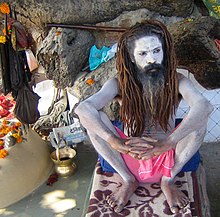Kamandalu

Kamandalu (
The water-filled kamandalu, which is invariably carried by ascetics, is stated to represent a simple and self-contained life.The kamandalu also used in
Method of making
The kamandalu may be made of various materials, including metal, clay, wood and dry gourd. For making the gourd kamandalu, a ripe pumpkin is plucked and the inner plum and seeds are cleaned. This leaves only the outer shell, which is used as the kamandalu. This is interpreted on a spiritual level as the removal of ego from a person. The ripe pumpkin represents the person, seed being the ego. Cleaning the seed thus symbolizes the removal of ego, forming a cleansed person fit to accept self-realization. [5]
In Hinduism

Water in a kamandalu represents
Several mythological stories refer to the kamandalu.

The mythical
Another river Silambu has a similar tale of origin. When Brahma washed Vamana's foot by the water of his kamandalu, one of the drops fell from Vamana's foot on the earth turning into the river.[19] Another mythical tale about the pilgrimage place Darsha Pushkarini, narrates how sage Agastya trapped river Kaveri in his kamandalu, when she declined his marriage proposal. This led to famine in the region and, noticing this, Kaveri escaped from kamandalu but with a curse of the sage and was finally purified at Darsha Pushkarini.[20] A variant tells that, angered by Kaveri's confinement, god Ganesha, in the form of a crow, pushed Agastya's kamandalu down, rescuing Kaveri and leading to the river's formation.[21]
In the Sarada legends of Kashmir (based on oral tradition) narrated by Romesh Kumar, it is said that when Ravana was engaged in a war with Rama, goddess Parvati advised Rama to take her to Uttarakhand away from the war scene. Thus, Parvati was carried by Hanuman in the form of water in a kamandalu to be dropped wherever she desired to be dropped. Wherever Hanuman rested on his way to Uttarakhand, drops of water which fell out of the kamandalu on the ground formed the springs Masanag at Gushi and the Devibal spring at Tikr in Kashmir—the kamandalu was kept in a nearby hillock where Parvati rested whereas a Sarada shrine exists. At Amarkantak, the source of river Narmada in Madhya Pradesh, an ancient kamandalu which is always filled with water, is called the Brighu Kamandal.[22]
The text
In Buddhism and Jainism
References
- ^ Monier Williams Sanskrit-English Dictionary (2008 revision)
- ^ http://sanskritdocuments.org/all_sa/shankara108m_sa.html, Shankarachrya's ashtotaram)
- ISBN 9788120808126. Retrieved 2008-08-20. p.40
- ^ http://www.hindudharmaforums.com/archive/index.php?t-448.html, Sanatana Dharma for Kids: Hindu Trinity: Brahma - Sarasvati
- ISBN 9781872883816. Retrieved 2008-08-21. p.48
- ^ ISBN 9789074597074. Retrieved 2008-08-21. p.52
- ISBN 9781406739862. Retrieved 2008-08-21. p.117
- ISBN 9788178240169. Retrieved 2008-08-21. p.40
- ISBN 9780791453056. Retrieved 2008-08-21. p.240
- ISBN 9788120805576. Retrieved 2008-08-21. p.146
- ISBN 9788170172284. Retrieved 2008-08-21. p.92
- ^ https://web.archive.org/web/20050207221439/http://www.pichu.info/nav.htm, Suryanar Koil
- ^ http://www.geocities.com/bhagvatjee/bhaag/kathaa/skandh8/9matsya.htm[dead link]. Sri Mad Bhagavat Puran, Skand 8, page 9, Chapter 24)
- ISBN 9788120820081. Retrieved 2008-08-21. p.187
- ISBN 9780195168327. Retrieved 2008-08-21. p.103
- ISBN 9788120817579. Retrieved 2008-08-21. p.60
- ISBN 9780791402498. Retrieved 2008-08-21. p.160
- ^ https://web.archive.org/web/20091027080628/http://geocities.com/dr_gda/ganga.htm, Origin of Holy River Ganga
- ^ [1] Deep in the Woods
- ^ http://saranathantg.blogspot.com/2008_03_01_archive.html, Srimad Bhagawat Geeta
- ^ http://chennaionline.com/columns/Lifehistory/history05.asp,(Agastya–Part[permanent dead link] V
- ^ http://www.kashmirsentinel.com/jan2003/16.html, Sarada Legends – Different versions
- ISBN 978-0-9793051-1-5. Retrieved 2008-08-21.
- ISBN 9781402700330. Retrieved 2008-08-21. p.225
- ISBN 9789074597029. Retrieved 2008-08-21. p.28
- ISBN 9780824827830. Retrieved 2008-08-21. p.93
- ISBN 9788170173755. Retrieved 2008-08-21. p.195
- ISBN 978-90-04-03902-5. Retrieved 2008-08-21. p.97
- ISBN 9788120816916. Retrieved 2008-08-21. p.164
